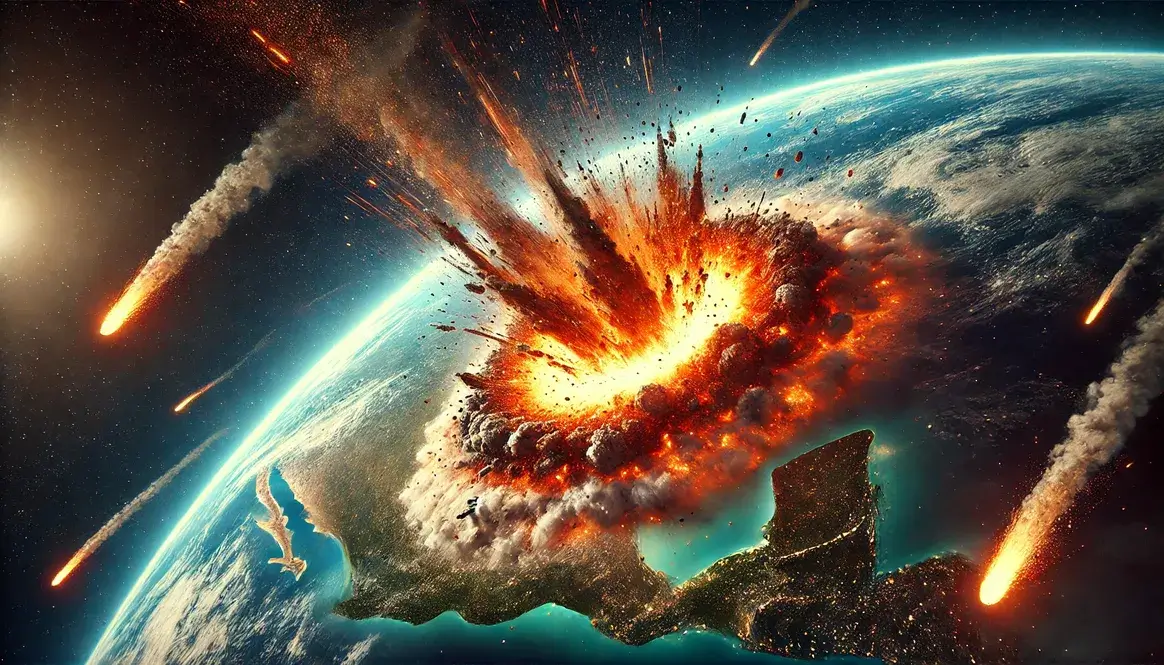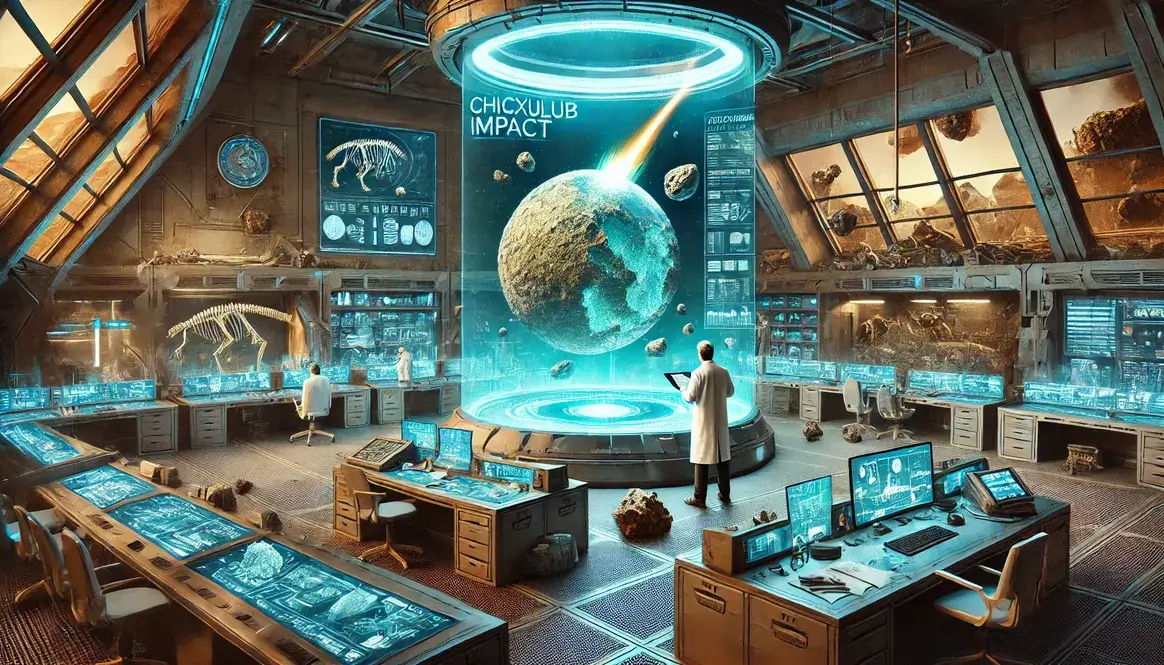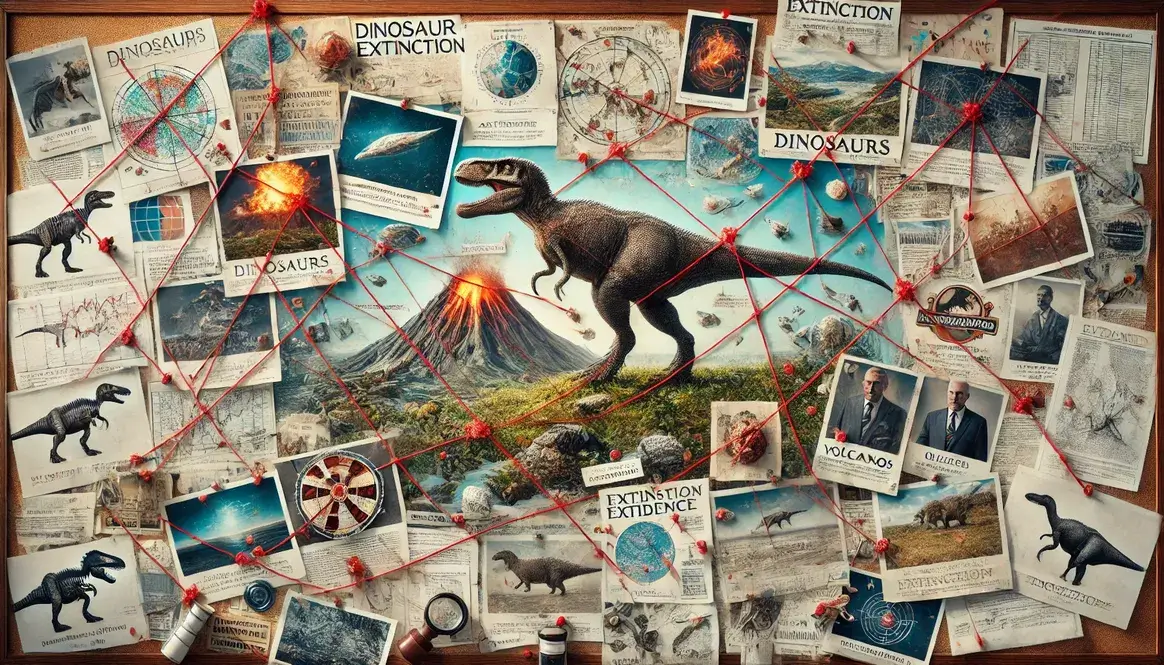About 66 million years ago, Earth experienced a catastrophic event that would forever change the course of life on our planet. A massive asteroid, roughly 10 kilometers wide, slammed into what is now the Yucatan Peninsula in Mexico. This cosmic collision marked the end of the Cretaceous period and triggered a chain of events that led to the extinction of non-avian dinosaurs and many other species.
The impact was incredibly powerful, releasing energy equivalent to billions of atomic bombs. It created a massive crater, known as the Chicxulub crater, and ejected huge amounts of debris into the atmosphere. But the destruction didn’t stop there. One of the most devastating consequences of this impact was the generation of enormous tsunamis that reshaped coastlines and devastated marine ecosystems worldwide.
Tsunamis from Dinosaur Asteroid: The Aquatic Aftermath
The asteroid impact didn’t just affect the land and air; it also created chaos in the oceans. When the asteroid hit, it triggered massive tsunamis that swept across the ancient seas. These weren’t your average waves – they were walls of water of unimaginable size and power.
Mechanics of Impact-Generated Tsunamis
So, how exactly does an asteroid create tsunamis? It’s all about energy transfer. When the asteroid hit the Earth, it did so with incredible force. This energy was quickly transferred to the water in several ways:
- Direct water displacement: The impact created a temporary crater in the ocean, pushing water outward in all directions.
- Seismic waves: The impact generated powerful earthquakes, which in turn created tsunamis.
- Debris fall: Ejected material falling back into the ocean caused additional waves.
These processes combined to create multiple tsunami waves that radiated outward from the impact site.
Estimated Size and Power
Scientists have used computer models and geological evidence to estimate the size and power of these tsunamis. The results are mind-boggling:
| Tsunami Characteristic | Estimated Value |
|---|---|
| Initial wave height | Up to 1.5 km |
| Wave speed | 720 km/h |
| Energy released | 30,000 terajoules |
To put this in perspective, the initial wave height was about as tall as five Empire State Buildings stacked on top of each other! The tsunami’s speed was faster than a commercial jet airplane, and its energy was equivalent to about 7 million tons of TNT.
These massive waves would have devastated coastal areas around the Gulf of Mexico and the Atlantic Ocean. But their effects weren’t limited to nearby shores. The tsunamis from the dinosaur asteroid traveled across oceans, impacting coastlines worldwide and leaving a lasting mark on the planet’s geology and ecosystems.
Global Reach: The Tsunami’s Path of Destruction
The tsunamis from the dinosaur asteroid didn’t just affect the immediate area around the impact site. These massive waves spread across the ancient oceans, reshaping coastlines and altering ecosystems worldwide. Let’s explore how these devastating waves affected both nearby and distant shores.
Near-Impact Devastation
The areas closest to the Chicxulub impact site faced unimaginable destruction. The Gulf of Mexico and the Caribbean experienced the full force of the initial waves:
- Coastal obliteration: Entire coastlines were completely reshaped, with beaches, estuaries, and coastal forests wiped away.
- Inland flooding: The massive waves pushed far inland, flooding areas that had never seen the ocean before.
- Marine life decimation: Shallow water ecosystems were utterly destroyed, with countless marine species wiped out in an instant.
The force of the waves in these areas was so strong that they likely carried large boulders and chunks of the seafloor for miles, depositing them far inland. Imagine house-sized rocks being tossed around like pebbles!
Distant Shores: Far-Reaching Effects
But the tsunami’s destruction didn’t stop at nearby coastlines. These powerful waves traveled across oceans, affecting shorelines around the world:
- North American coasts: The eastern seaboard of North America faced massive waves, potentially reaching heights of hundreds of meters.
- South American impact: Coastal areas of South America experienced severe flooding and erosion.
- European shores: Even the ancient European coastlines, thousands of kilometers away, felt the tsunami’s effects.
- African coasts: The western shores of Africa also faced significant wave action.
The global impact of these tsunamis was unprecedented. They transported sediment and marine life across vast distances, altering ecosystems and leaving behind geological evidence that scientists study today.
One of the most fascinating aspects of these far-reaching effects is how they contributed to the K-Pg extinction event. The tsunamis, combined with other effects of the asteroid impact, played a crucial role in the mass extinction that followed.
These waves didn’t just reshape coastlines; they reshaped the course of evolution on our planet. The devastation they caused opened up new ecological niches, paving the way for the rise of new species in the aftermath of the extinction event.
Ecological Upheaval: Impact on Marine and Coastal Life
The tsunamis from the dinosaur asteroid didn’t just reshape coastlines; they caused a massive upheaval in Cretaceous ecosystems. From the depths of the oceans to the edges of coastal forests, the waves left a trail of destruction that would alter the course of evolution.
Devastation of Shallow Marine Environments
Shallow marine ecosystems bore the brunt of the tsunami’s fury. These areas, teeming with life, were hit hard:
- Coral Reefs: Ancient coral reefs, much like their modern counterparts, were delicate ecosystems. The tsunamis likely obliterated many of these underwater structures, destroying habitats for countless species.
- Coastal Fish: Fish populations in shallow waters were decimated. Many species, unable to escape the powerful currents, were swept far inland or out to sea.
- Invertebrates: Creatures like mollusks, crustaceans, and echinoderms faced extinction in many areas. Their inability to quickly move to safety made them particularly vulnerable.
The impact on these environments was so severe that it left a clear mark in the fossil record. Scientists studying sediment layers from this time period often find a distinct “tsunami deposit” – a jumbled mix of marine and terrestrial debris that tells the story of this catastrophic event.
| Ecosystem Component | Immediate Impact | Long-term Consequence |
|---|---|---|
| Coral Reefs | Widespread destruction | Slow recovery, habitat loss |
| Coastal Fish | Mass die-offs | Population bottlenecks |
| Invertebrates | Local extinctions | Evolutionary opportunities |
Destruction of Coastal Terrestrial Habitats
The tsunamis’ effects weren’t limited to the oceans. Coastal terrestrial environments also faced unprecedented destruction:
- Coastal Forests: Entire swaths of coastal vegetation were uprooted or drowned. This not only destroyed habitats but also removed crucial barriers that normally protect inland areas from the sea.
- Land-Dwelling Creatures: Animals living in coastal areas faced a double threat. Those not killed directly by the waves often found their habitats destroyed, leading to widespread die-offs.
- Nesting Sites: Many dinosaur species used coastal areas for nesting. The tsunamis likely wiped out countless nests, eggs, and young, dealing a severe blow to already stressed populations.
The destruction of these coastal habitats had far-reaching consequences. It disrupted food chains, altered local climates, and forced surviving species to adapt quickly or perish.
In the aftermath, the landscape was forever changed. Salt water inundation made many areas uninhabitable for previous plant species, altering the composition of recovering ecosystems. This massive disruption, combined with other effects of the asteroid impact, contributed significantly to the mass extinction event that marked the end of the Cretaceous period.
The ecological upheaval caused by these tsunamis serves as a stark reminder of the interconnectedness of Earth’s ecosystems and the profound impact that catastrophic events can have on life’s diversity.
Geological Signatures: Reading the Tsunami’s Story
The tsunamis from the dinosaur asteroid left behind more than just destruction. They also created a unique geological record that scientists can read like a book, revealing the power and extent of these massive waves. Let’s explore how geologists uncover and interpret these ancient traces.
Sediment Deposits: Layers of Evidence
One of the most telling signs of ancient tsunamis are the distinct layers they leave behind in the rock record. These deposits, known as tsunamites, provide crucial information about the event:
- Composition: Tsunamites often contain a mix of marine and terrestrial materials, reflecting the tsunami’s ability to carry debris from different environments.
- Grading: The layers typically show a characteristic grading pattern, with larger particles at the bottom and finer sediments on top.
- Extent: The size and distribution of these deposits help scientists estimate the tsunami’s reach and power.
In many locations around the Gulf of Mexico and beyond, geologists have found evidence of massive deposits that align with the timing of the end-Cretaceous impact. These layers often contain a mix of marine fossils, land plant debris, and even small fragments of the asteroid itself!
| Deposit Feature | What It Tells Us |
|---|---|
| Thickness | Wave height and energy |
| Particle size | Wave speed and power |
| Fossil content | Ecosystems affected |
| Chemical composition | Origin of sediments |
Erosional Features: Scars on the Landscape
While deposits tell one part of the story, the tsunami’s erosional power left its own distinct marks on the landscape:
- Coastal Cliffs: In some areas, the tsunamis carved out new cliffs or dramatically reshaped existing ones.
- Inland Channels: The force of the waves cut new channels far inland, leaving behind evidence of the tsunami’s reach.
- Boulder Fields: In coastal areas, fields of large boulders transported by the waves serve as testament to their immense power.
These erosional features, when studied alongside depositional evidence, help paint a comprehensive picture of the tsunami’s impact. For example, in parts of the Caribbean, scientists have found massive boulders dozens of kilometers inland, far from any natural source. These “tsunami megaboulders” provide stark evidence of the waves’ incredible force.
The study of these geological signatures isn’t just about understanding past events. It also helps scientists better prepare for potential future impacts. By understanding how Earth’s biggest impacts affected our planet in the past, we can better predict and prepare for similar events in the future.
Geological evidence of the end-Cretaceous tsunamis continues to be discovered and studied. Each new find adds another piece to the puzzle, helping us better understand this pivotal moment in Earth’s history and the powerful forces that shaped our planet’s past – and potentially its future.
Cascading Effects: Beyond the Initial Impact
The tsunamis from the dinosaur asteroid weren’t just a one-time event. Their effects rippled through time, contributing to long-term changes in Earth’s systems. These cascading effects played a crucial role in shaping the post-impact world and influencing the course of evolution.
Altering Ocean Chemistry
The massive waves didn’t just move water; they fundamentally altered the chemistry of the world’s oceans:
- Nutrient Redistribution: The tsunamis stirred up the oceans, bringing nutrient-rich deep waters to the surface and sweeping coastal nutrients out to sea. This redistribution likely caused:
- Algal blooms in some areas
- Nutrient depletion in others
- Sediment Suspension: Huge amounts of sediment were suspended in the water, potentially:
- Blocking sunlight
- Altering pH levels
- Affecting oxygen content
- Salinity Changes: The inundation of coastal areas with seawater changed local and regional salinity patterns, impacting marine ecosystems.
These changes in ocean chemistry had far-reaching effects on marine life. Species that survived the initial impact now faced a dramatically altered environment, forcing rapid adaptation or extinction.
| Ocean Change | Short-term Effect | Long-term Consequence |
|---|---|---|
| Nutrient redistribution | Algal blooms | Shift in marine food webs |
| Sediment suspension | Reduced photosynthesis | Changes in ocean productivity |
| Salinity alterations | Local die-offs | Evolution of salt tolerance |
Contribution to Global Cooling
The tsunamis also played a surprising role in the global cooling that followed the asteroid impact. Here’s how:
- Carbon Sequestration: By burying large amounts of organic matter (plants, animals, and plankton), the tsunamis effectively locked away carbon that would otherwise have returned to the atmosphere.
- Albedo Changes: The tsunamis’ destruction of coastal vegetation and deposition of light-colored sediments may have increased Earth’s albedo (reflectivity), contributing to cooling.
- Ocean Circulation Disruption: The massive influx of freshwater from melting ice caps, combined with tsunami-induced mixing, likely disrupted ocean currents. This could have amplified the cooling effect by altering heat distribution patterns.
These factors, combined with the impact winter caused by dust and aerosols in the atmosphere, contributed to a period of global cooling. This cooling had profound effects on both marine and terrestrial ecosystems, further stressing already vulnerable species.
The tsunamis’ role in these long-term changes highlights the interconnected nature of Earth’s systems. What began as a mechanical disturbance of the oceans cascaded into chemical, biological, and climatic effects that reshaped the planet’s ecosystems for millions of years to come.
Understanding these cascading effects provides crucial insights into the complexity of mass extinction events and the delicate balance of Earth’s systems. It also serves as a reminder of the potential long-term consequences of major disturbances to our planet’s environment.
Lessons from the Past: Modern Implications
Studying the tsunamis from the dinosaur asteroid isn’t just an exercise in understanding ancient history. It offers valuable insights that can help us prepare for future challenges and better understand our planet’s systems. Here’s what we can learn from these prehistoric waves:
- Disaster Preparedness: While an impact of this scale is rare, studying its effects helps us prepare for other large-scale disasters. We can:
- Improve tsunami warning systems
- Develop better evacuation strategies
- Design more resilient coastal infrastructure
- Climate Change Insights: The rapid climate shift following the impact provides a stark example of how quickly Earth’s systems can change. This can inform our understanding of:
- Tipping points in climate systems
- Long-term effects of sudden environmental changes
- Ecosystem resilience and recovery
- Biodiversity and Evolution: The mass extinction that followed the impact, partly due to the tsunamis, offers lessons about:
- The fragility of ecosystems
- The importance of biodiversity for resilience
- How species adapt to rapid environmental changes
These ancient tsunamis also highlight the interconnectedness of Earth’s systems. The waves’ effects cascaded from the oceans to the atmosphere, demonstrating how a single event can have far-reaching consequences.









